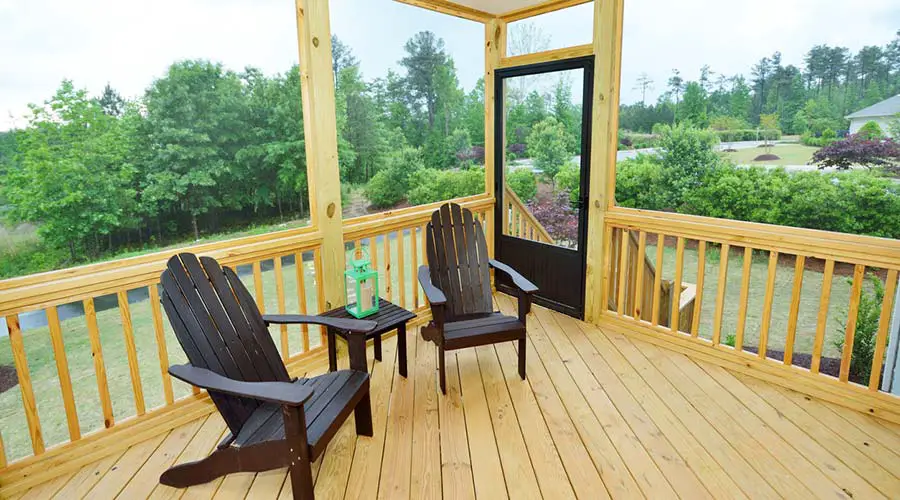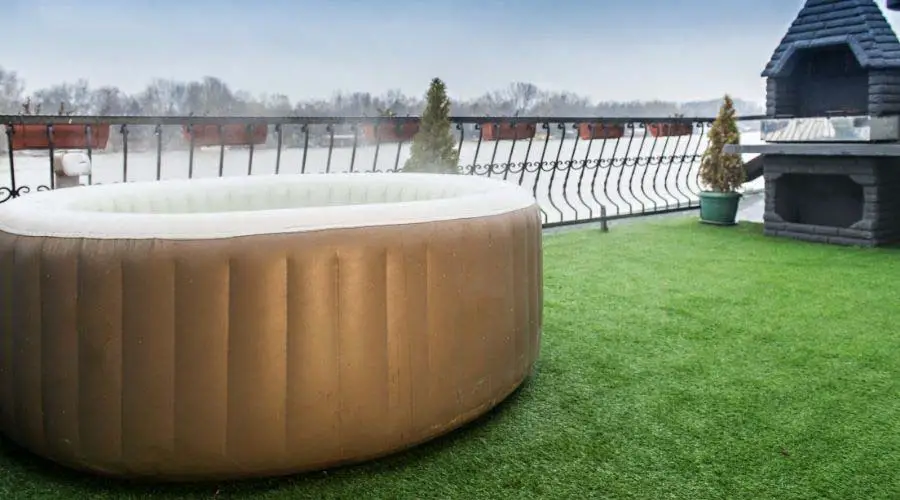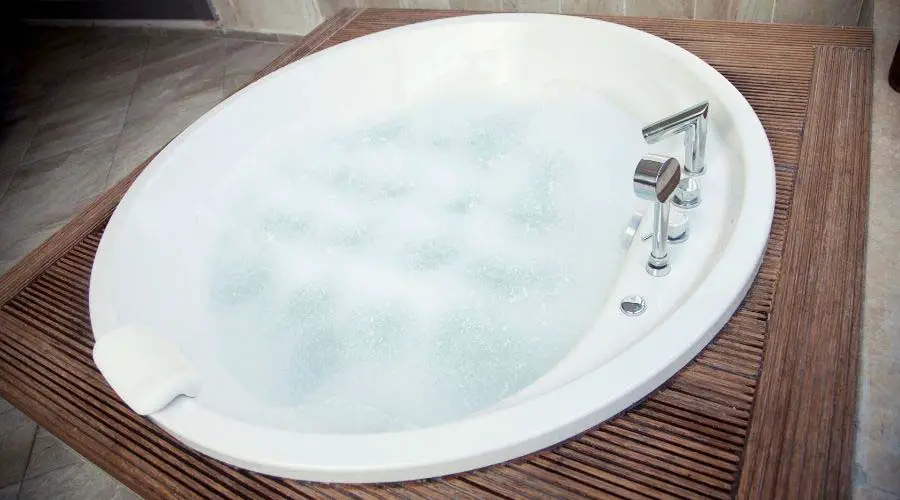
If you’re like me, you like to entertain the thought of a hot tub or outdoor kitchen on your deck. Well, it’s not as simple as taking a weekend out of your schedule and plopping a heavy object on there.
There are quite a few factors that go into the decision. First, you must consider the amount of weight your deck can hold from the ground up.
Typically, a deck can hold a minimum of 50 pounds per square foot. However, that number assumes your deck is to code without the deck’s weight taken into account. Overall, there are several factors to consider when thinking about how much weight a deck holds.
That’s not all that you have to consider when adding a new edition to your deck. To truly understand the extent of the weight your deck can handle, start from the bottom up.
How Much Weight Can the Average Deck Hold?
For you to check the actual weight an average deck can support, you must consider the following factors such as:
- Foundation
- Framing
1. A Strong Foundation
Before we even get to the math, you have to know the load-bearing potential of your foundation. Understand how much pressure the parts below your deck can take.
That’s because no matter how strong your deck is, if the foundation it’s on is weak, you’re going to have a situation on your hands.
Much of a foundation is to support lateral loads. When a hurricane, earthquake, or any other instance of extreme changes to the environment hit your hometown, secure framing will help prevent your deck from toppling over.
It’s essential to the topic because if you have heavy objects sitting on your deck that is firm in good conditions but is at risk when those conditions change, your deck doesn’t have the proper build to hold those objects.
Sturdy Footings
Your footings will be instrumental in achieving the maximum weight your deck can handle in many cases. The foundations spread the heavier loads out over the surface area of the ground and hold the deck in place.
If you are in the beginning stages of planning to build a deck, remember that overbuilding could be the difference between getting that heavy new grill you like in a few years and settling for a lighter model.
Typically, deck footings range from 8 to 24 inches in diameter, 12 inches being the standard diameter. At the same time, the size of your footers won’t directly interact with the weight your deck is holding. Larger footings allow the stability to transfer to other areas of the deck.
So, if you’ve built your deck yourself and assume that it can hold heavier objects, you should first ensure that your footings are up to code to avoid any mishaps.
Soil Bearing Capacity
The soil bearing capacity will tell you if whatever you put on your deck will end up leaning sideways or sinking your deck into the ground. There’s no point in having a hot tub if your water is spilling out.
| Soil | Load Bearing Capacity PSF |
|---|---|
| Clay | 2,000 |
| Sand | 3,000 |
| Gravel | 5,000 |
| Sedimentary rock | 6,000 |
| Crystalline bedrock | 12,000 |
Your soil should hold 1500 pounds per square foot. Of course, certain soil types, including gravel and sandy gravel, will contain more.
It could hold up to 12,000 pounds per square foot if it’s crystalline bedrock. If you are unsure what your soil bearing capacity is, you can quickly contact an engineer to find out.
The steps to ensure your foundation is up to code are as follows.
- Footings must exceed the frost line
- The top of footings must be level
- Concrete strength should be 2,500 psi
2. The Framing
The frame of your deck is responsible for carrying the weight load of the party on the deck. This part is stable will prevent a collapse or tilt from the weight above.
Lumber for Posts
Typically, a few types of lumber will make up the posts of all but the shortest decks.
- SYP (Southern Yellow Pine)
- Western Cedar
- SPF (Spruce, Pine, and Fir)
- Redwood
- Red Pine
The species of wood used will give you a sign of how stable your deck is. The more powerful posts made from woods like SYP and SPF will only add to the load-bearing capacity along with your soil and footings.
Fasteners
When it comes to load-bearing capacity, the fasteners are essential because they are what hold your deck tightly together.
Having extremely durable fasteners will help hold your deck up if you add a heavy object to it. Also, the type of screws used will tell you if your deck can take heavier weights.
Only having the bare minimum in terms of fasteners and nails will decrease the amount of weight your deck could hold, regardless of a strong foundation.
Four things will give your deck the best edge when fighting the battle of load capacity.
- Hurricane ties
- Post-to-beam connectors
- Joist hangers
- Use heavy-duty hardware like hex-head wood screws
In addition to having a solid framework, ensuring that your deck meets these frame requirements will ensure that it meets the standard.
- Lumber labeled and treated with preservatives
- Size appropriate joists
- Use 6×6 support posts up to 16 feet off the ground
Understanding Loads
Now that we’ve covered the aspects of your deck that significantly affect your decks’ load-bearing potential, we have to consider the types of load. For instance, we talked about lateral load capacity, responsible for withstanding shaking or wind pressure.
The standard capacity commonly talked about when adding a heavy object to a deck is gravity loads. Experts break them down into the two categories of live loads and dead loads.
1. Dead Load
Dead loads include the weight of the materials used to create the deck. When deciding the weight your balcony can hold, you have to calculate the dead load into the equation not to overload it.
For example, if your deck meets the minimum of 50 pounds per square foot, you’d take one-fifth of that weight out of your equation to accommodate the dead load, making it 40 pounds per square foot.
2. Live Load
Live loads are likely the reason you’d want to know how much weight your deck can handle. Whether it’s for a pool, a party, or a place to put your lawnmower collection, these things contribute to reaching its live load capacity.
It’s important to mention that snow also adds to that capacity, so if you find that your deck is nearing the weight it can take, and your roof has a tendency to dump snow onto the balcony, you’re pushing the limits.
How Much Weight Can a Deck Block Support?
You can add or take away from the weight-bearing potential for your deck.
If your deck is 10×10, you will have 4,000 pounds in live load potential. However, you won’t realize that weight-bearing potential unless you build the deck correctly to withstand that pressure.
| Deck Size | Square Feet | Dead Load | Live Load |
| 10 x 10 | 100 | 5,000 | 4,000 |
| 12 x 12 | 144 | 7,200 | 4,760 |
| 15 x 15 | 225 | 11,250 | 9,000 |
| 20 x 20 | 400 | 20,000 | 16,000 |
As you can see, the max load capacity of your deck when it is up to code increases by 50 pounds per square foot the bigger it gets. That means that a 10×10 deck holds up to 4,00 pounds in live load.
How About a Composite Deck?
A fast-growing trend among homeowners is the composite deck. It is a wood alternative that lasts longer than the traditional lumber deck due to its artificial materials.
Decks like this won’t rot or become vulnerable from water damage and some of the other pitfalls of a wood deck.
In addition to some composite decks being quite environmentally friendly, they require little maintenance. That said, since a majority of a deck’s strength comes from below, they will typically hold the same amount of weight as a wood deck with an equal build and size.
Adding to Your Deck
When adding heavy objects to your deck, you must understand the load your deck can take in a concentrated area.
You have to calculate the weight and square footage of the object and match it to the load capacity per square foot of the deck.
While opinions vary on a deck’s load-bearing potential, there are a few that homeowners tend to go to.

1. Inflatable Hot Tubs
Portable hot tubs are relatively light in weight and do not include some parts that would make a hot tub extremely heavy. An inflatable hot tub will not exceed 3,000 pounds when it has water and people inside.
However, with these hot tubs being around 7 feet in diameter, your deck must be able to withstand more than the minimum of 50 pounds per square foot.

2. Kiddie Pools
Although these pools have the reputation of being small with lightweight people inside, they become heavier than expected.
The risk to your deck also increases the more you use a pool on a wood deck. Warping, rotting, and other damage associated with moisture can weaken a deck over time, decreasing its load capacity and placing the kiddies in danger.
The smaller pools that contain the minimum amount of water shouldn’t be an issue. Although, the moderate to large kiddie pools could weigh significantly more.
Water weighs more than 62 pounds per square foot. If you add children jumping and splashing around, you could load well over the minimum load capacity.
So if you have one of these kiddie pools, make sure your deck can withstand well over your deck load capacity, including people.

3. Molded Hot Tubs
Rotomolded hot tubs are some of the most affordable and long-lasting hot tubs you can buy. They are also much lighter than the more traditional acrylic hot tubs.
That said, they still weigh about 300 pounds before adding water and 6 to 7 adults. So if you plan to have a molded deck, consider reinforcing it to fit the weight of these mid-sized tubs.

4. Outdoor Kitchen
When you love cooking outside for games or family events, an outdoor kitchen can be just what you need. However, the weight of an outdoor kitchen can easily top 800 pounds.
In addition to reinforcing your deck to account for an oven, grills, and whatever else you want on it, your setup should be near the house where the load capacity is its highest.

5. Acrylic Hot Tub
These fiberglass tubs sometimes have steel sheets added to reinforce the load. Even when they are empty, they can put 1,000 pounds of pressure on our deck. Needles to say, it’s essential to ensure that your deck can handle this kind of weight.
When one of these vast tubs fills up with people and water, you could easily have over 6,000 pounds sitting on your deck in a concentrated area. Don’t let that discourage you.
It is possible to add a deck of this size and weight to your patio with the proper reinforcement. The joists, beams, screws, and fasteners you use can be the difference between a relaxing evening and an expensive clean-up.

6. Adding a Pool
A larger-sized pool on your deck could cause several issues. The biggest problem with pools is the weight of water affecting the wood and the constant swaying movement weakening the frame.
Adding a pool to your deck is a serious project that requires a helping hand from a professional to ensure that everything goes right.
Experts recommend at least implementing 2×8 joists every foot across the deck. The footings should surpass the typical 4 feet and instead be 8 feet into the ground with 4×4 marine treated lumber secured.
There are several other safety precautions to take when adding a pool.
- Use pressure-treated planks for decking
- Wood-seal the deck annually
- X braces at 12-inch intervals between joists
- Remove pool after swimming seasons
- Use even spaced floor planks
Planning Ahead
There are areas of your deck that will be most stable, making them the most supported parts to place heavy objects. Finding those tributary areas will help prevent an incident when deck conditions worsen.
Typically, the footings at the base of your deck are vital areas, but depending on the size and shape of our deck, there could be other areas that indicate strong support.
Now that you know how to add objects to your deck safely have fun enjoying your new project. Be sure to make sure your deck complies with code and that you perform regular maintenance to prolong the longevity of your outdoor sanctuary.
Sources














